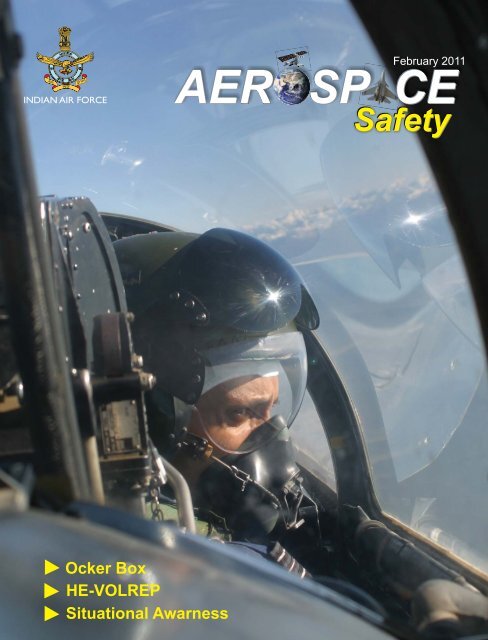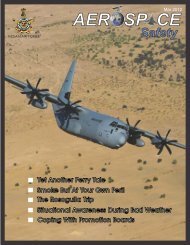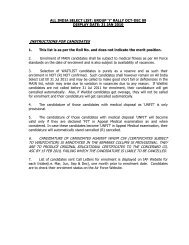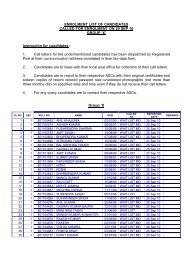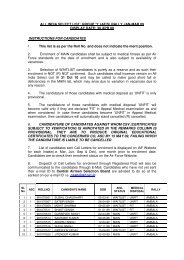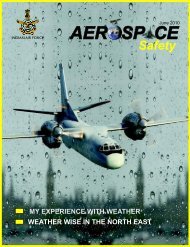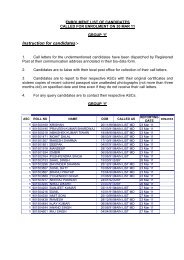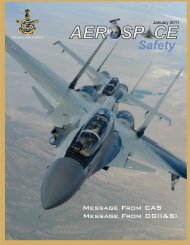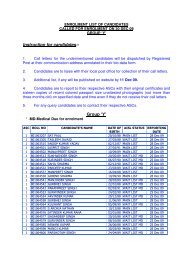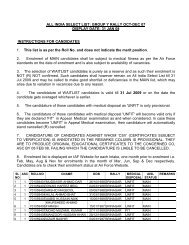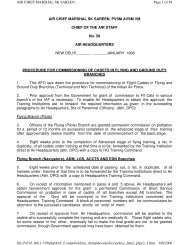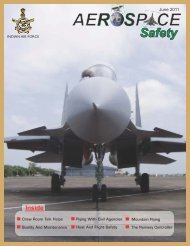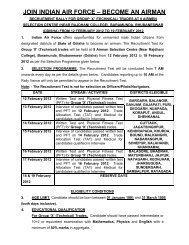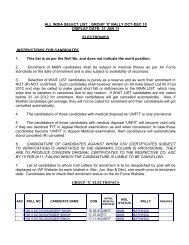February 2011 - Indian Airforce
February 2011 - Indian Airforce
February 2011 - Indian Airforce
You also want an ePaper? Increase the reach of your titles
YUMPU automatically turns print PDFs into web optimized ePapers that Google loves.
Wg Cdr DS DeshpandeIt was a typical flying day. Night flying wasplanned for the fully ops pilots for routinepractice missions in dark phase. After a smallchat with the COO following the Met bfg, I gotairborne for a procedures sortie. Everything wasnormal until the rejoin.Three aircrafts including mine were in the airas I joined circuit. I was no. 3 in landing sequencebehind a trainer and a fighter, who were on shortfinals and base leg respectively. After loweringlanding gear, I heard a call of “suspecting tyreburst” from the trainer captain who had justlanded. Engrossed with my cockpit actions andplanning for the landing, it took me some time torealise what had actually happened, but I promptlyraised landing gear and checked my fuel state.Meanwhile, the fighter, who was on short finalswas told to go around as the trainer had blockedthe runway. From the R/T calls between the ATC,pilot and the crash crew (don’t know why they callthem crash crew, should be safety crew), it wasapparent that the two of us would have to divert.After loweringlanding gear, I hearda call of “suspectingtyre burst” from thetrainer captain whohad just landed.Engrossed with mycockpit actions andplanning for thelanding, it took mesome time to realisewhat had happenedbut I promptly raisedlanding gear andchecked my fuelstate.After some confusion as to which base todivert to, we were asked to proceed to XXX, thefarther diversion. I checked my fuel, It was 1000ltrs, sufficient for YYY (the closer diversion) andmay be just enough for XXX. The journey to XXXrequired a mandatory climb to 6 km altitude asit involved crossing the sea (the Gulf of ZZZ). Ireluctantly increased power to climb. The otherpilot commenced climb behind me. He had about100-150 ltrs of fuel more than me. I leveled outat 6.5 km and asked Paws (an experienced butjunior pilot) to level out at 6 km. We changed overto XXX approach frequency and informed themof the diversion. When asked, I informed my fuelremainder, which was 600 ltrs. On this I receiveda query “Confirm 600?” It was by a Su-30 pilot inthe neighbouring sector! I was ahead of Paws buthigher and decided to let Paws position first forthe landing. Visibility was good and I could seethe glow of XXX city lights from a distance but thiswas no time to admire the view. Half way over theGulf, a red warning light glowed in my cockpit; the2 Aerospace Safety F e b r u a r y 2 0 11INDIAN AIR FORCE
450 ltrs fuel remainder signal. I started positioninglong finals for runway AA. As I announced thatI would report long finals for runway AA, theapproach controller informed me that runway inuse was ZZ and not AA.Another decision to be taken. Should Ido a visual circuit or a surveillance approach?I remembered what I always professed-“unfamiliar base/ bad weather/ emergency onboard -take radar assistance”. I opted for thelatter and asked for an SRE approach. On hearingmy call, the old Su-30 pilot piped up again. “Confirmyou want to do an SRE?” He was going nuts in hiscockpit hearing these ridiculous fuel figures. Hiscall was taken by the radar controller as a decisionthat a radar vector was not the best choice. Aftera while which appeared long enough to me inwhich no controlling had commenced, I reachedover the city. This should be the end of my troubleI thought.But not yet... My ADF and GPS indicated thatI was over the airfield but I could not locate therunway. From overhead the airfield at an altitudeof 2 km, the airfield was the only dark area in themilieu of a brightly illuminated city. To add to mywoes, when I picked up what I thought was the flarepath, I saw another one, the cross runway, both ofwhich were lit up! My gyros were literally toppled.There I was – at night over another base, with fuelenough for just over one circuit and runway notin sight. Meanwhile, Paws reached overhead tootrying to land at the earliest.So did it result in two ejections or flames out orwrong runway landings or mislandings?No.Paws spotted the flare path, did a teardrop turnand reported right base and landed (the circuitpattern is left hand). I did one orbit over the airfieldwith my fuel gauge showing 300 ltrs, oriented in2-D space, turned downwind and landed, knowingfully well that I had only one attempt at landing.Both taxied to a nearby apron and switched offwith fuel 180 and 250 ltrs. As we walked towardsa nearby building, we saw a vehicle stop. It wasthe ol’ man who had landed just behind us. Butinstead of meeting us, he headed straight to ourac to see our fuel gauges! Needless to say, herelived (our) horror.All is well that ends well. So why am I tellingyou this tale, you’d wonder. After all you’ve heardthis and few of you’ve done ‘that’ or even scarierthings. The reason is – lessons can be learnt evenfrom day to day events which go unreported andundebriefed.So what was it that went wrong?One, after hearing the call of tyre burst, I wastedfuel in doing one full orbit overhead as I assumedthe trainer was simulating an emergency whichthe COO had asked me to simulate. Two, I didnot persist with the controller and insist that hecomplete my surveillance approach.What did I do right?One, I did not panic on seeing the low fuelwarning and Two, I showed faith in the surveillanceradar and sought assistance when required.Few questions to which I haven’t got answersare:- Why did the SRE controller stop vectoring meon hearing my fuel state and hearing ol’ man’s callof “Confirm you want to do SRE?”Why were both (cross) runways lit up? Why was another diversion (YYY) not availablewhen the landing fuel was less than that requiredto divert to XXX? Did the ol man’s anxious queries help ourcase? You decide.- Wg Cdr DS DeshpandeINDIAN AIR FORCE 2 0 1 1 F e b r u a r y Aerospace Safety 3
Sqn Ldr S SrinidhiSqn Ldr Vinayak SharmaFinding difficulties in managing peacocksespecially during morning and eveninghours is a common feature in entire northIndia. As this bird enjoys special status in India,the modules are to be designed carefully andwith sensitivity. Before reaching to any conclusivemodule following facts are to be understood.Legal Status. The peafowl, Pavo cristatus(Linnaeus), is the national bird of India andprovincial bird of the state of Punjab. Huntingof peacocks is banned in India. It is protectedby parliament statute. These birds are given fullprotection under the wildlife (protection) Act 1972.Characteristics. The male bird, peacock ischaracterized with a 2.12m (7.32ft) length, in fullbreeding plumage. The female bird is knownas peahen, which is 86 cm long. These birds areknown as member of the pheasant family. Peacockis predominant ground bird, it prefers to remain onground and fly only for roosting or when threatened.They usually live for about 20 years and has recordsof living up to 40 years.4 Aerospace Safety F e b r u a r y 2 0 11INDIAN AIR FORCE
Habitat. This bird is mostly found inthe dry semi desert grasslands, scrub, anddeciduous forest and feeds on mainly grains,seeds, but also eats insects, fruits, reptiles,berries, figs, leaves and flower parts. They liveon ground and generally do not venture out farin the open land. Staying close to shrubs andtrees provide an escape from predators. Theyalso follow a routine path over a period of time.Breeding. The peacock maintains asmall territory and chooses a part of it for alek (a gathering of males for the purpose ofcompetitive mating display). Peafowl startreproducing around the age of two years.During the mating season each peafowl maymate up to six different peahens. The Peahen,lay between 4 and 6 light green /Tan eggs in ashort period in spring. Their breeding seasonstarts with the monsoon rains. The incubationperiod is 28 days. A happy peahen will lay moreeggs, more often, while a stressed Peahen maynot lay any eggs at all, or just one or two onlyonce. A peahen abandons a nest, if she finds toomuch commotion in the vicinity of her nest.Nesting. The peahen makes a scrape inthe ground, lined with sticks, where she laysseveral light green or tan eggs. She sits on themconstantly for about 28 days. Out of every sixchicks that hatch, usually only two survive tojoin the rest of the flock. Mothers leave the nestonly once a day, usually flying making a lot ofnoise, probably to distract predators from theeggs.Daily routine. Peafowl follow a certain dailyroutine. They roost overnight in large groupsin tall, open trees. That way they are safe frompredators during the night. In the morning theybreak up into small groups. In non breedingseason there are usually groups of all peacockor all peahens but during breeding season thereare groups of one peacock and several peahenor all bachelors. Around mid day, peafowls drink,preen their feathers, and rest in the shade. Aftercooling down, they go back foraging for food,take one last drink and return to their roost forthe night.Predators. Peacocks have a number ofnatural predators in the wild that include wilddogs, fox, coyote, owls, weasels, hawks, cats,raccoons ,black bear ,leopards and even tigers.As peahens nest on ground, they are exposed topredators because they do not leave their nestand if they do, it might be very late.Modules Suggested Identify the area of roosting of peacocks. Clearthe growth of vegetation under the tall trees(shrubs and bushes in these areas) so that thepeahens cannot hide their nests from predator. Feed Cats and dog in these areas frommonsoon season so that their presence createstress for peahens and reduce its probability oflaying eggs. Peahens generally do not nest awayfrom roosting area. Play sound of predators e.g. tigers once in awhile in the evening and morning, especially inthe areas preferred for roosting by peacocks. Identify the water bodies which thesebirds visit, in evening for drinking water beforeproceeding to roost. Positioning even a chowkidarat the frequented place during the period ofactivity will help immensely.It must be borne in mind that no direct harmshould be made to Peacock for the legal statusenjoyed by this bird. In-direct measures suchas nest and natural predator centric modulesshould apply to control the menace of peacocks.The above modules can be implemented tomanage peacocks where ever such menace isencountered.- Sqn Ldr Vinayak Sharma and Sqn Ldr SSrinidhiINDIAN AIR FORCE 2 0 1 1 F e b r u a r y Aerospace Safety 5
Air Cmde A SubramaniamIwas having dinner the other night with an exparatrooperfriend of mine who now handles RiskManagement for one of the Global IT majors. Formost of the evening, he was on a conference call withthe Canadian Police and an international organisationcalled SOS, trying to fix up the repatriation of the bodyof a young software engineer on an off shore projectwho hung himself, possibly due to stress, lonelinessand other symptoms that are commonly called asclassic ingredients of the ‘No Way Out Syndrome’. Asthe evening progressed, I had the opportunity tolook through some of his e-mails to his brother. Thecontents were sad and chilling to say the least. Let’scall the techie X and his brother Y.X: Anna (brother in most South <strong>Indian</strong> languages),I am feeling low and want to talk to you.Y: What time is it dude! Get some sleep.X; Anna, I can’t sleep-I went to the Departmentstore and wasted $80 on provisions that I don’t evenneed. I do not know what is happening to me.Y: I am busy yaar-don’t bug me. Get some sleep.X: I can’t sleep-I do not know what is happeningto me. Everyone else is so smart at office. I need to talkto you. Last time I felt good when I spoke to you.Y: Shut the f------ up and go to sleep. Be a manand pull up your socks.X: ( Next morning) Anna-I am feeling better-slepta while-have sorted things out.6 Aerospace Safety F e b r u a r y 2 0 11INDIAN AIR FORCE
The boy hung himself that evening!! I knowthat this morbid tale was not a very pleasant wayto ring in the new year, but it reflected on sometypical stresses of our times that all of us need toreflect on.We in the IAF can consider ourselves damnlucky that compared to the stressful corporateworld, we have a set up that is based oncommunity living, team work and group dynamicsthat positively impact not only our professionallives, but also our personal lives. We mostlylive in camps and cantonments, breathe freshair and lead relatively insulated and protectedlives. In recent times however, environmentalstress, financial pressures, family commitments,unrealistic professional expectations and a hostof other stressors are manifesting themselvesin our daily lives in various forms, We hear ofcardiac problems and diabetes at ridiculouslyyoung ages, increased marital conflict and otherpsychosomatic disorders. There is an urgent needto look at these as a great danger to Flight Safetyin particular, and to our unique way of life ingeneral.Having gone through a fair amount ofprofessional and personal stress over the yearsmyself ( and I daresay that most people of my ageand service would have experienced the same),I have always strived to understand it and sharewhatever thoughts came my way in various formaland informal forums. Let us face it! Stress in militaryservice is inevitable, particularly so when thesafety of human lives and expensive equipmentis at stake, be it in peace or conflict. Therefore,the first step in effective stress management is toface it headlong and not run away from it. Typicalresponses or attitudes that reflect an individual orteam that displays this approach are-:A can do attitude We have a problem-Let’s tackle it-or ‘We havemade a mistake-Let’s move on after facing theconsequences squarely. So what if I/we have not succeeded this time-Let us try again---- and so on. There are so manypositive statements and actions that can makeadversity seem trivial and surmountable.The second step in my lexicon that hasparticularly helped during my leadershipassignments has been the process of leveragingthe benefits of ‘positive stress’ for bothorganisational and personal growth, while at thesame time mitigating and restricting the negativeimpact of stress on the individual and the team.However, this is where things can get tricky as theonus of separating the’ good stress’ from the ‘badstress’ rests largely with the leader. How muchto push, when to push and whom to push areextremely critical.My last primer relates to the effectivenessof a ‘people centric and informal approach’ tostress management as against a more formalcounsellor and therapy driven approach that isgaining popularity. While I am not discountingthe importance of such formal mechanisms,I would still reiterate the effectiveness of theformer in acting as our first line of defence. It isin this context that I would urge our younger airwarriors to talk to their friends, colleagues andseniors about their problems, however trivialthey may seem to be. I would also suggest to ourleaders in the field to devote more time to lendinga patient hearing to those in distress; it will alwaysbe time well spent! The two main impedimentsto this approach are current trends of ‘protectingprivacy’ amongst the younger generation andthe reluctance of many in my generation to shiftfocus from upward mobility and climbing thepyramid to helping others solve their problems.We need to reflect more on such issues if wewant to run an organisation that is battle worthy,effective, efficient and empathetic.So Go on Talk to Someone about Anythingthat is Worrying you-Anytime—It helps.- Air Cmde A SubramaniamINDIAN AIR FORCE 2 0 1 1 F e b r u a r y Aerospace Safety 7
Wg Cdr GS Bishen10 Aerospace Safety F e b r u a r y 2 0 11INDIAN AIR FORCE
What is SA?Feeling RushedSituational awareness is an accurateperception of the factors and conditions affectingyour task or operation, now and in the future -keeping ahead of the task and monitoring thebigger picture.It involves perceiving what is going onaround you, understanding what this means andprojecting forward to anticipate what will happennext. Situational awareness can be individual,interteam or intrateam.Improving SAIn developing situational awareness duringa task, we must start off with an accurateknowledge of the system or environmentstatus. We must consider our intended actionsand its appropriateness in the circumstances.Also, try to anticipate (and discuss) what thenegative outcomes could be. And lastly, wemust understand how our actions might effectour operation, the larger environment and otherpeople.Once we have an adequate level of situationalawareness the next task is to maintain it.Constant review of available data againstour understanding is essential to maintainingsituational awareness. A head-down focus onspecific elements of a task at the expense of allother information will not allow a good level ofoverall situational awareness to be maintained.Effective communication ensures the transferof appropriate information in order to allow forbetter checking of facts against understanding.How do you know when your situationalawareness is degraded?ConfusionUnexpected resultsNarrowing of task focus Increasing anxiety, or gut feeling - if it doesn'tfeel right.Loss of, or degraded situational awarenessis a key factor in many incidents/ accidents.Recovery from it (once it has been detected)must be a deliberate and careful process.Do not carry on and try to understandat any cost - it is also very difficult to changeyour perception, once you have arrived at anunderstanding. Increased confusion may resultfrom attempts to understand a problem whilestill trying to complete the task.Debrief what happened. Lessons learnt arevaluable information to prevent others fromrepeating the same mistakes.Accurate situational awareness do`s anddon'ts:- Assume nothing - always confirm yourunderstanding from fact Maintain constant and appropriate levels ofcommunication Do not focus in on any one single element ofa task to the exclusion of everything else.If it feels wrong it probably is, If situational awareness is degraded to thepoint where it could effect safety - stop andcheck and / communicate to get help from allpossible players. Safe flight = safe height / safe track /safeairspeed / safe configuration.- Wg Cdr GS BishenINDIAN AIR FORCE 2 0 1 1 F e b r u a r y Aerospace Safety 11
- drops them home...but forgets to explainthe dosage of the medicines to his wife, and indouble fast speed reaches back to the squadron...is 15 minutes late.... immediately assumes dutyafter getting a big shout from his supervisor andgets going with the work on the aircraft. Whenthe aircraft goes for a ground run in the evening,there is a screeching sound and the technicianremarks: Oh !! I left a spanner inside. Imaginary,but possible.When the medical assistant is asked abouthis role in Flight Safety, his answer : How are LPmedicines for a child connected to flight safety?You ask the treating MO. Why did he not prescribemedicines that were available in the SMC? Simpleanswer- these were better? But was he aware thatthe procedure took three days? No, that’s SMOresponsibility. Any relation with flight safety? Youmust be joking? Ask the SMO? Simple answer...The procedure takes that much time. MOs shouldbe aware of what is available in the SMC, and mydoors are always open for everyone if anyonehas a problem! Flight Safety: how do medicinesprescribed for a baby affect flight safety- theseare remote, absolute remote connections!The same scenario can be visualised in anyother section- Accounts, Admin, Engineeringservices, Logistics etc. Claims processed late,individuals with financial responsibilities, PORs nottaken, advances delayed, clothing not available,accommodation deficient, accommodationcomplaints not attended to promptly andefficiently and so on... the list can be endless.We can think of a whole lot of activities in everysection. The affected individual is obviously notat peace with himself mentally where he can givehis 100% to the ‘aircraft’ task. And if we were toask the host individual if any of these were relatedto flight safety- we will definitely get surprisedand bemused look! But as elaborated in detailabove, they all have the potential to adverselyaffect flight safety.I am sure that all these individuals will tell usthat flight safety relates to ‘flight’ and ‘flying’.There is a section dedicated for this and theyare so spatially and temporally distant from theaircraft and the runway, how could they possiblyadversely influence flight safety. A typical ‘it’snot my baby ‘it’s his baby syndrome’. This needsto change. Flight safety activities within theorganisation at all levels need to take an ‘inclusive’look and approach rather than being consideredas an ‘exclusive’ directorate, section activity at alllevels. Flight Safety has to become ‘everyone’s’baby.Why should flight safety become ‘our’ baby?We need to bring/inculcate the ‘our’ conceptbecause of the critical significance of a mind freefrom worries when operating in/ near an aircraft.14 Aerospace Safety F e b r u a r y 2 0 11INDIAN AIR FORCE
Could this daily briefing incorporatesome innovative concepts. It could bea picture of the area depicting beforeand after condition, may be a picture ofthe equipment used in maintaining theaerodrome clean, may be a picture of theman operating these equipment, maybe highlighting the importance of eachactivity, may be the quantum of work andwork analysis in terms of man hours, maybe a flight safety thought for the day, maybe some interesting feature covered byASIO/MSIO.From the MTD in the aircraft manoeuvring area,to the technician working on the aircraft, to thepilot who occupies the seat in the cockpit, tothe technicians working on the aircraft in thehangars to the air traffic personnel and the birdwatchers—each one of them needs to be ableto give his one hundred percent to the job onthe aircraft- and for that, every individual in thestation, in every task he is doing, has to contributetowards safety- by ensuring that he does not addin any way to the worries of the individual directlyconnected with aviation activities- by conveyingto them that flight safety is ‘our ‘ baby and that‘we care ‘ for him.Is this change possible?Can we bring about a change where flightsafety becomes ‘our baby’ for everyone, whereevery individual in the IAF thinks flight safety inwhatever he/she does? Yes, we can. In the nextfew paragraphs I will try and suggest some stepsthat we can take to try and possibly bring aboutthese changes.Firstly, the daily flight safety briefing. Are theytoo drab and monotonous, such that while welisten yet do not perceive either the content orany obvious changes in the data and their flightsafety implications, e.g., a typical flight safetybriefing daily would cover the labour/ workdeployment of the previous day, work statusand work planned for that day. At the most, ofinterest only to the AOC, CEngO, CADMO is theavailability/ serviceability of the jungle jims andthe manpower available/not available. Couldthis daily briefing incorporate some innovativeconcepts. It could be a picture of the areadepicting before and after condition, may be apicture of the equipment used in maintainingthe aerodrome clean, may be a picture of the manoperating these equipment, may be highlightingthe importance of each activity, may be thequantum of work and work analysis in terms ofman hours, may be a flight safety thought for theday, may be some interesting feature coveredby ASIO/MSIO. If not daily, atleast on a regular/periodic interval. These are simple steps whichcan be implemented and I feel can have definiteimpact on the awareness about flight safetyactivities in a station. Not that some of theseare not done, they need to be done in a way ‘toinvolve’ the audience.Similarly, the weekly flight safety briefingconducted in most stations cover the accidentor incident rates and a brief narrative circulatedabout the event is read out. All these can be mademore interesting or interactive, possibly by askingquestions from the audience, the significance/implication of the incident that have occurred,and again some thought for the week. If theincident rate within the command is showingan upward trend compared to previous years orINDIAN AIR FORCE 2 0 1 1 F e b r u a r y Aerospace Safety 15
other commands, the flight safety officer couldprovide some insights into the possible causes andmeasures adopted towards ensuring safe flying inthe station. I have seen some Commanders askingthe youngsters the relevance / learning value forthem from the incidents occurring at anotherstation. If not done, they merely become a drabaffair. Although this will require extra effort onthe part of safety section but I personally feel thatthis will pay off in the long run as far as flight safetyis concerned.Station flight safety activities beyond theroutine. There is no doubt that the flight safetypersonnel at a station are engaged in a lot ofactivities and any suggestion for out of the routineactivities will meet with a lot of resistance. Of theroutine activities that are conducted at a stationand those that consume a lot of manhours arethe ‘cleaning’ and ‘housekeeping’ activities andpreparation and display of posters. Occasionalposter competitions are held. Let’s say we havea quarterly quiz for personnel on the contentsof flight safety magazine with prizes thrown inas incentives. Such an activity will serve dualpurpose- firstly, enhance the awareness amongpeople about special flight safety features andsecondly increase the readership of flight safetymagazine which no doubt is a very educative tool/component of the entire flight safety programme.We could also have essaycompetitions, debates, a dedicated flightsafety week/ fortnight to observe flightsafety activities on a larger scale. Again,involve each section (which we do by theway of flight safety theme of the month),give each section some funds to designinnovative material with regard to flightsafety pertaining to that section. Andthen let their section outline/ discusswhat they did in the ensuing flight safetymeeting rather than just putting acrosswhat they did on a power point slide,which as it is does not register in a wholelot of cases. Let me give an example. Theflight safety theme for the month of April10 was ‘Medical Boards and Exams’. At ourSMC we sincerely put in efforts towards achievingsome of the key areas that were circulated fromCommand HQ. Beyond those, we carried out anaudit/ workflow analysis of our medical boards.We introduced an integrated investigation formfor patients with hypertension which replaced5 different forms. No big deal some may say!! Butwhen you have 100 odd cases of hypertension whoneed these forms quarterly/yearly, we will definitelysave time/ manhours both for the med/asst and thepatient. Even the small savings are cumulativelyhuge. After all, HDFC bank wants you to withdrawcash from ATM 40% faster and imagine the timesaved???Yet, when I put across the work done for themonth on a power point slide the whole meaning/implication of this achievement was lost. No onereally understood what we meant. May be if I hadexplained this, a whole lot of other officers wouldhave gone back to their workplace and tried toanalyse their work processes. After all, we do learnfrom each other. Similarly, if one of the engineeringsubsection came up with some innovative way ofhousekeeping/ cleanliness/ antiskid methods inthe hangers/ accounting of tools etc, these wouldhave implications across all sections and can beadopted once explained in detail rather than as asingle bullet point on a ‘busy’ slide.16 Aerospace Safety F e b r u a r y 2 0 11INDIAN AIR FORCE
ecome the new face of flight safety in thestation. Flight safety will become their baby,when they’ll see their names along withthe slogan, they will put that into practice,motivate others to do, and will think moreabout flight safety - thus making flight safetyan ‘our’ concept.Special professionally designed /videos/publicity materialEveryone will agree that flight safety shouldlargely be a preventive effort-cleanliness/maintenance all directed to prevent FOD/incidents. The flight safety people do prepareinteresting slogans/ publicity material, but therehas been a distinct lack of any ‘catchy slogans orfocused sustained campaign that would attractand retain client/ user interest. Probably, we needthe services of a specialised professional agencyto do this for us. I have yet to see a flight safetyvideo of the IAF with which we all can relate to. Istill remember the impact, Mission Udaan videohad on me when I first saw it and continues tohave the same impact even now. Such jobs arebest done by experts in their own fields.Another thought which comes to mind. Everystation has flight safety slogans painted on thewall, glow signs, flexi boards - where do thesecome from? Honestly I don’t know- but I guesseither from the flight safety directorate, CFSIO,SFSIO, or picked up from magazines from otherair forces or now easily from the internet. Howabout inviting each air warrior to submit flightsafety slogans? Those selected, should be paintedin the station along with the contributor’s nameandthen updated every three /six months. In thisway, a whole new breed of air warriors, incognitoand not connected with flight safety so far, willWe will also get inclusive by involvingmore and more people in any safetyrelated programme in the station. Weknow from experience that OHR boxes /HEVOLREP boxes are grossly underutilised.Let’s get together people to complete aquestionnaire form with their thoughts on theexisting flight safety activities - their opinions,their role, their involvement and the good andbad of the existing activities and how to improvethem. Questionnaire forms when left for people tocomplete and submit generally do not produce agood/ satisfactory response rate. But when madeto sit down as a collective activity and permittingit to be anonymous, the response can be prettypositive.I am confident that such an activity will provideus with valuable insights on the thinking of the‘common man’ as far as flight safety is concernedtheyoung medical asst or the admin asst whomay consider himself to be remote from any iotaof flight safety will suddenly be involved. We willbe successful in getting views from our clients. Wewere successful in doing so, by soliciting collectivefeedback from patients on our system and servicesat SMC (which we always believed were of a veryhigh order): a reality check so to say.Bringing the change from ‘his’ to ‘our’ is notgoing to be easy or happen overnight. After all weare giving each air warrior something additionalto think about! A conscious effort has to be madewhich in the long run becomes natural to each oneof us. Whether at home or office, eventually safetywill become our baby!!!- Gp Capt Narinder TanejaINDIAN AIR FORCE 2 0 1 1 F e b r u a r y Aerospace Safety 17
Blast From The Past18 Aerospace Safety F e b r u a r y 2 0 11INDIAN AIR FORCE
This is a recorded interview on locationbetween a fighter pilot (FP) and a staff officer(SO). Any semblance to questions that mayhave been asked before and answers that mighthave been given are purely coincidental. TheAuthor reserves the right not to be quoted.F.P. What do you mean by supervision?S.O. Well, to cut a long story short the dictionarydefines supervision as ‘the act of inspection orcontrol’. Since the emphasis is on the word act, ‘itreally means that under the act you are all liableto be blamed for lack of it.F.P. What is meant by motivation?S.O. It is that quality in an individual to ascend theladder of progress himself, and once he reaches aparticular level the service thereafter provides it.F.P. What is meant by judgement?S.O. It is a rare quality to be seldom found in badofficers and abundantly found in good officers.Fine judgment is to differentiate between thesetwo categories.F.P. Why are the procedures for nearly everythingin the service so complicated and laborious.S.O. Because fella, if something goes wrong itwill be difficult to find the culprit.F.P. Our accident rates are calculated for 10,000hrs flying and given as a rate per 10,000 hrs. Pleaseexplain.S.O. Some bright Johnny, said if you can fly10,000 hrs and not have a single accident you are100% safe. The very next sortie after completing10,000 hrs he crashed and killed himself. We’vemaintained this figure to his memory.F.P. Recently, a lot of restrictions on drinking, bartimings and flying have come into force. Why thesudden clamp down and caution? After all, themajority of us spend Rs 75’/- per month (enoughto keep a convent girl sober at current rates) andall the stuff that is filtered through our livers hasthe ISI stamp.S.O. You know the old-adage ‘the best cure fora hangover is to stay drunk’. Well those daysare behind us now. To ensure that our aircrewmaintain sober habits without actually enforcingtotal prohibition, we have laid down all theserestrictions, I’m sure you have read all the articleson ‘Flying and Alcohol’. Stick to them son! itsyour best insurance for a longer life.F.P. Don’t you think that if a more liberal policywas followed like laying down guide lines andconducting seminars on the evil effects ofdrinking rather than imposing restrictions, itwould have a more profound effect? After all itshuman nature to break rules and delve into theunknown.S.O. A point there. We are looking into thataspect also.F.P And finally, I was just wondering whetherthere is any career planning for aircrew.Notwithstanding the ‘P’ Staff Forum what is thefunction of the Career Planning Cell?S.O. A very sore and touchy point. But to answeryour question in a nutshell. For the first 20 yearsof your career you are on your own. The next 10years we start planning your career and by thetime a career is planned for you, you are about toretire. Its still better than some other countriesI know!- Reproduced From the SAFETY JOURNALpublished in SEP 1975 written by PEGINDIAN AIR FORCE 2 0 1 1 F e b r u a r y Aerospace Safety 19
LAC AK SinghLife in Communication Flights (Com Flt)is considered to be very peaceful. It isassigned to convey VIPs and top IAFofficials to different places on official tours/visits.Thus, the serviceability of the aircraft forthese commitments becomes paramount. Anyunservicability (whether technical or manual)at the last moment, hampers the commitmentand puts the STO and DSS personnel, in aspin. One such incident that took place in theCommunication Flight is worth mentioning.An AVRO aircraft was planned to take off at 0700hrs to Delhi with a VIP onboard. For this, the earlyparty gang was detailed to report at 0400 hrs. Allthe tradesman including the SNCO i/c and the WOi/c were busy doing their job in order to make twoVIP aircraft serviceable by 0600 hrs; one as mainand the other as standby. An airframe tradesman,during the Dl of No. 1 VIP aircraft noticed that themain accumulator pressure of the aircraft wasunder-reading. He immediately brought the aircharging cylinder to charge the accumulator but20 Aerospace Safety F e b r u a r y 2 0 11INDIAN AIR FORCE
The poor airframe tradesman then ran towards the hanger tochange over from overhaul to uniform as VIP see off is done inuniform. By the time, he reached the Bay in uniform, the VIP hadalready arrived. The technician immediately put on his marshallingjacket and was ready with his marshalling bats.unfortunately found that there was inadequatepressure in the cylinder. He reported this to theSNCO i/c of the aircraft. The SNCO i/c detailedother tradesmen, who had completed their Dl, toload a new cylinder on trolley from a distant placeand bring it to the aircraft. It was done and the No.1 VIP aircraft was made serviceable by 0545 hrs.The WO i/c then informed the tradesmen tocarry out Dl of the No. 2 aircraft too. The airframetradesman while doing the Dl was asked to hastilyfinish the Dl as he was required to ‘man’ the brakeof No. 1 VIP aircraft which was being shifted to BayNo. 1 for VIP see-off. He quickly finished his joband proceeded for shifting the No.1 aircraft. Bythe time the aircraft was positioned in Bay No. 1, itwas 0630 hrs. The poor airframe tradesman thenran towards the hanger to change from overhaulto uniform as VIP see-off is done in uniform. By thetime, he reached the Bay in uniform, the VIP hadalready arrived. The technician immediately puton his marshalling jacket and was ready with hismarshalling bats. The Co-pilot, Navigator and theground crew were already inside the aircraft. TheCaptain and COO of the station were outside toreceive the VIP.When the VIP boarded the aircraft the engineswere started as per SOP. After the warm up checks,the aircraft was ready for departure. The marshallersignalled the Captain to taxi-out. Everyone couldhear the increase in engine power as the throttlewas increased. Suddenly three fluorescent ribbonsbegan to flutter, one behind the nose oleo leg andthe other two behind the main oleo legs. The COOnoticed it and immediately ran to the marshallerto tell him about this. The marshaller prompltlysignalled the Captain to stop. The SNCO i/c ran tothe aircraft and took out the jury pins which wereattached with the florescent ribbons from the threeoleo legs. These jury pins act as a safety measure toprevent the three oleo legs from retracting on theground. Before flight, they must be removed or else,the oleo legs will not retract in the air. The airframetradesman by this time realized his blunder. He wasresponsible for taking out the jury pins before takeoffand placing them inside the aircraft. Had the aircraftdeparted with the jury pins intact, the undercarriageswould not have retracted. As a result, the aircraftwould have had to make an unwanted landing andthus delay the commitment. After the aircraft finallydeparted everyone began questioning the airframetradesman and sought for his statement.Why it happened?:- Numerous hurried jobs arising in quicksuccession.Arrival of the VIP before the stipulated time. Build up of unwarranted stresstechnician.Lesson learnt:-on the In stress, whatever is seen by an individualmay not draw adequate response from the brain. All checks and procedures must be donemeticulously. Supervisors must ensure no unwarrantedstress accumulates on their technicians.- LAC AK SinghINDIAN AIR FORCE 2 0 1 1 F e b r u a r y Aerospace Safety 21
Sqn Ldr Juhi BorgohainIn aviation’s early days, pilots flew by the “seatof their pants.” They trusted their eyes and gutfeelings, even though doing so sometimes killedthem, especially when vertigo set in at night orduring bad weather. Such loss of equilibrium wasconsidered part of the business, a rite of passagethat fliers just had to handle. Till date, SpatialDisorientation (SD) remains the numero unostressor in aviation. It has costed many a lives andaircraft. It is for this reason that the maximal use ofground- based SD training devices is encouragedfor the physiological training of pilots.The story of invention of DisorientationSimulators is something that is quite interesting. Doyou know who invented the SD Simulator? Well, itwas none other than a pilot himself!Colonel William Charles Ocker, also known asthe “Father of Blind Flying” was a veteran pilot inthe US Army in 1920s. In World War I, he had knownmany competent fliers who became disorientedand died needlessly; he himself had narrowlyescaped death when lost in the clouds with novisibility, he discovered that the flight indicatorshowed his plane in a turn while his senses toldhim he was straight and level. The confusion senthim into a spiral dive: emerging from the clouds,he had just enough time to regain control. Ocker,rather than blaming the instruments understoodthat, despite his training and experience, his pilotinstincts had failed him.The story of disorientation is as old as theorigin of the word ‘pilot’ itself. Well, the wordpilot is derived from the name ‘Pilatre deRozier’ - the first person to fly. Pilatre flew in a hotair balloon launched by the Montgolfier brothersof France in 1783. He is said to have had a feelingof disorientation during his first free floatingballoon flight across Paris.Throughout his career, Ocker remained hauntedby his close call and the reasons why it happened.Years later, a routine physical exam by a flightsurgeon, Capt. David Myers, provided him withsome answer. Dr. Myers sat Ocker in a Barany chair,a swiveling, spinning seat designed to measure aperson’s sense of balance and equilibrium, andchallenged him to take the exam with his eyes closed.Ocker discovered that when robbed of visual cueshe couldn’t tell whether the chair was spinning orstationary, or even what direction he turned. Myershad re-created the same disorientation that Ockerhad once experienced in the clouds.22 Aerospace Safety F e b r u a r y 2 0 11INDIAN AIR FORCE
Ocker devised a way to beat Myers’s test byrigging a turn indicator and penlight inside acovered shoe box with a viewing hole cut in oneend. Seated in the chair, he held the box up tohis face and watched only the instrument. Eventhough he was “flying blind,” he could now tellMyers precisely which way he moved and how fast.Ocker had proved that conflict can exist betweena pilot’s subjective perceptions and the readingsof his instruments—and that he should trust theinstruments, not his instincts, when that occurred.Ocker perfected his “Ocker box,” addingstandard aircraft instrumentation such as acompass and artificial horizon, so that pilots coulduse the box in conjunction with the Barany chairas a training device. Even the most experiencedaviators could not help but be convinced after aspin in Ocker’s rudimentary flight simulator.Ocker contributed tremendously to improveflight safety by researching pilot disorientationduring poor-visibility conditions. He was thepioneer of instrument flying. Indeed, he rides withevery pilot who relies on instruments to find theway home!SD DemonstratorsOver the years, the significant advances inaviation have challenged the medical professionto help protect the health and safety of the pilots.The research and development in the field ofspatial disorientation have led to the emergence oflatest generation SD demonstrators e.g., the oneat the Institute of Aerospace Medicine and AMTC.These devices use somatogyral and somatogravicvestibular illusions, as well as focal and ambientvisual illusions to create disorientation in thetrainee, who “flies” the cockpit by reference to flightinstruments.Education and TrainingIf a disoriented pilot recognises his predicament,he is well along the road to recovery. RecognisingSD is not easy, however. Physiological training andthe knowledge of how to do a good instrumentcross-check is the main weapon against SD atthe disposal of the pilot, and the flight surgeon/aviation medical examiner. The emphasis topilots is on a two stage approach for preventingdisorientation mishaps.First, the pilot must be aware that he is havinga problem holding altitude or heading. This cannotbe done if he is concentrating on something otherthan the flight instruments, e.g., the radar scope.Minimize the likelihood of SD by monitoringfrequently and systematically the critical flightparameters (bank, pitch, vertical velocity, andaltitude); conversely, expect to become disorientedif attention to these flight parameters is allowedto lapse due to misprioritization of tasks at hand.A proper flight training is must to appreciate theneed for appropriate task prioritization and toinstil the discipline of continuous instrumentcross-check.Second, when disorientation does occur,recognize it as such and act. This ability is promotedthrough physiological training that provides anexperience of conflicting orientation cues. Earlierthe standard advice was to believe the instruments.Now the advice is to “make the instruments readright”, regardless of sensation. Education to pilotson the subject of SD emphasizes on (a) avoiddisorientation by making frequent instrumentcross-checks, and (b) recover from disorientationby making the instruments read right.The profound and pervasive influence ofour orientation senses in aerospace operationscannot be ignored; through knowledge andunderstanding, however, it can be controlled.Pilots can meet the demands of the environmentand function effectively if they are trained andprepared.Happy Soarings !!- Sqn Ldr Juhi BorgohainINDIAN AIR FORCE 2 0 1 1 F e b r u a r y Aerospace Safety 23
Gp Capt S Ghosh24 Aerospace Safety F e b r u a r y 2 0 11INDIAN AIR FORCE
But in my generation, the young officerswould rather be in the field every day, playingtroop games like football, hockey or basketball.Cricket was still an elite game meant forSunday mornings to be washed down withbeer and Golf had not yet taken root. Sadly,not many follow that profile any longer and thebi-weekly PT days are best avoided. ‘Extreme’heat or ‘drizzle’ are good enough reasons toseek cancellations.Iam 47 years old and getting into an age bracketwhere the general discussion on health is towatch your diet and take long walks. Goodadvise that, but what do I do if I wish to eat well,love my drink and yet remain healthy? Brisk walkhelps, but will it win my battle against the bulge?Not too sure.I first went to the gym ten years back. Ratherlate to start, considering that a lot of youngpeople throng the gyms – in the armed forcesand the civvies street. But in my generation, theyoung officers would rather be in the field everyday, playing troop games like football, hockey orbasketball. Cricket was still an elite game meantfor Sunday mornings to be washed down with beerand Golf had not yet taken root. Sadly, not manyfollow that profile any longer and the bi-weeklyPT days are best avoided. ‘Extreme’ heat or ‘drizzle’are good enough reasons to seek cancellations.A decade back, a kind soul introduced me tothe gym – just when I started getting disgustedwith this changed mindset and found myself inthe minority at the playfield – and I have sincenot looked back. Gymnasiums were availableat AF stations before, but I had a mental blockfor closed door exercise (except for squash) andpreferred to be in the open, sweating it out like a‘man’. This period was also my first tenure as staffat Command HQs and the office work seemed toosedentary.There are a plethora of reasons why Icontinued to visit that particular gym, the primereason being the upkeep – clean, healthy, airconditionedand supervised. Till then the gymsI had seen were sweaty, dingy-lit, bacterial denswith pieces of iron passing as apology to weights.I have since been regular except a tenure of AirHQs, wherein the work timings and stay in civviesstreet made it difficult to find a convenient gymwithin financial reach and not crowded enough.Luckily, the posting was to DASI, and I did makeup for the loss during the inspection visits – everyalternate week.Why am I penning my views on this subject?I am not giving you the results of a researchfrom books or the net – sure way to get onedisinterested since it would sound like aninformed sermon – but my personal experience, ajourney through the niceties of the environmentand the way it has helped change my outlook.So don’t expect a regimen drawn up nor a dietchart to supplement your exercise routine – onecan get it from the cyber space – I would expressthe ups and downs of the hour that I spend in thegym everyday – well almost an hour and almosteveryday – and the resurgent enthusiasm thatstays through the day.The process. One has a lot of questions relatedto the gymnasium. I will try and clarify a fewdoubts, as I see it.INDIAN AIR FORCE 2 0 1 1 F e b r u a r y Aerospace Safety 25
The best timeto visit the Gym.Anytime you find time.Many theories arepropounded wrt thebest time to be there,but to me, one mustnot get bogged downby such trivialities.You are the best judge– early morning, early/late evening, during abreak in office (if youroffice is lucky to haveone, I mean a gym) –suit your timings. For starters, make a routine andtry & stick to it. The first few days/weeks couldbe very trying – you will discover a lot of hithertounknown muscles courtesy the pain – a temptingreason to quit before you takeoff. So the routineand a bit of inner discipline helps. Pace of training. Don’t expect to be a JohnAbraham or a Salman Khan in a month’s time. Goslow and in sequence. As you age, its better totone rather than build muscles. The aim is to behealthy, look healthy and feel healthy. I wouldrecommend a six day routine, cardio everyday –use the treadmill, and then divide the body intothree sections – chest & up, abdomen & lower backand lastly the legs from thigh down. One sectionper day is a good way to start – Monday/Thursday,Tuesday/Friday and Wednesday/Saturday. God’sday is for rest. If the gym equipment has gradedlevels, start with the ‘basic’ or ‘beginner’. Workyour way up patiently to ‘expert’ in say, six months.This will ensure you stick and not say bye to thegym in about a month. Socialise. Gym is a good place to interact.The general view is that one must keep silent,be serious and exercise – a sure reason to quitbecause of the monotony. Most people enterthe gym with a focus and a similar aim. You canexpect very little gossip, discourage – if you findit. Talk generally borders to the bulges and waysto control and one gets wonderful tips fromveterans, but beware and learn to filter. The feelgoodfactor improves the quality of conversationon other subjects too. Good to have some softmusic going – it gets you going – let the beatsbe for the Jane Fonda gang and in the mat room.Whatever you do, don’t be oblivious to yoursurrounding and the co-gymmers, enjoy yourtime. It distracts you from the hard work and thepain. A word of caution – excess of socializing canbe counter-productive as well as a distraction toothers. Gym Ethos. Never hog the equipment. Spendtime adequately for your benefit and also cater forthe others. Follow the instructions to the T. Wronguse can do a lot of damage and can be dangeroustoo, when in doubt – ask. Don’t take the weightsand the mechanized equipment – especially theelectrical ones – for granted, it can be and hasbeen a great leveler. Be properly attired and stickto the rules, viz. wrt the timings. Be cordial andhelp out. In a nutshell, be disciplined and let theprocess be fun.Why Gym? A logical question is, why take somuch pain and what do I gain? I will try and answerfrom the personal as well as organizational pointof view. I have discussed a few personal benefits inthe previous paragraphs – I have only delved onthe physical. As the cliché goes ‘a healthy body isa prerequisite for a healthy mind’, and it sure is.On days that I miss a schedule, something goesamiss, the mind wanders, there’s a general lackof well being. I know it’s a mind thing, since thesame feeling does not recur when I intentionallymiss a session. There is a definite feel-good factorrelated to being in the gym. Its healthy too andthe frequency of visiting the SMC should reduceand serious illnesses can be kept at bay thatmuch longer. The physical well being translatesto a mental and emotional stability. As we age,our physical prowess tend to wane, it hurts when Idon’t intercept the ball in the football field – when26 Aerospace Safety F e b r u a r y 2 0 11INDIAN AIR FORCE
I think I could – or steal a quick single and findmyself stranded short of the crease. This happenssince one unconsciously compares ones abilitiesat the height of physical fitness to the present andtends to believe that the ability has not diminished.Workout in the gymnasium reduces that gap to anextent and keeps us ‘younger’ for a longer duration,physically and thus mentally. The organizational benefits are manifold. Ihave felt an improved work environment aroundme, I seem to be more patient and thus rationalin my decisions. Which leads to a better workenvironment for personnel in general, especially,if the person in question is high in the hierarchy.A commander/leader in high spirits does wondersto the subordinates and thus the organization.The work place seems bright. Positive as well asnegative vibes are infectious. When it comesfrom a superior, the feel-good or the tremor runswide. So, in the interest of your subordinates,keep fit, and thus happy. Secondly, as discussedearlier, outdoor activity is in the wane. One wayis to blame all and sundry down the line and passinstructions to enforce. The other is to be aware, tryand rectify slowly but steadily, taking into accountthe changed social milieu. The resultant lack offitness has started showing on the personnel andit gives a poor impression of the service to thecivilians. An averagely fit person is looked at inawe. Since the trend has been to move away fromoutdoor activities, try and check the rot, as well asfind alternatives. Gymnasium is a good option.As it gains popularity, the resurgent energy in thepersonnel will take them outdoors again. Andits a good hobby for the families too – most areignorant about the benefits of physical activityand tend to age early, physically and mentally.The Way Forward. It destroys my myth that‘sweating it out like a man’ can happen onlyoutdoors, it can in the gym too. There are twoaspects that need to be looked into when onewishes to initiate people onto an activity. First,provide the resources and convince them to use it.We need to move to healthy, aesthetically designedand friendly gyms and if possible, availabilityof expert advice and help – that’s the way Igot addicted. Don’t just stick to one gym in astation, have a few at easily accessible locations.The aim is to make it lucrative to the personnel& families – like their TV sets and the soaps – soas to wean them away from those weaknessesfor a certain period. The commanders need tofind a way around the rule books to build them.The best is to ask for a review and modify theauthorizations. Let the gyms be built as gymsand not be known by other names for theauditor’s consumption. Ensure that the timingssuit a vast majority of personnel and families.Having provided the resource, the second aspectis to convince people to use them. Nothing ismore criminal than creating a resource and notusing it. One will need a host of innovative waysto encourage people to start coming to the gym,and once they are used to it, proliferation is not aproblem. Measures could be personal examples,organized sessions (like the yoga camps) andtimings split between units and sections topromote a healthy competition for attendance,thus involving the unit/section supervisors init. Nothing works better than making peoplecompete – and this time for attendance – andpublically appreciating it. There would be manymore suggestions – more the minds, better theoutcome. Innovate and apply.In the preceding paragraphs, I have pennedsome of my thoughts on the subject. I havegreatly benefitted from this hobby and I believethat others have and will, too. Physical fitness isa soldierly trait and if we call ourselves soldiers,we need to be physically fit. For I believe, we aresoldiers first, and then comes our specializationsand/or the fact that we are officers or PBORs. Itwould be nice to see healthy and smiling facesaround us in every station and a lot of thatdepends on our inner well being – physicalfitness being a great contributor. So, keep fit andkeep smiling.- Gp Capt S GhoshINDIAN AIR FORCE 2 0 1 1 F e b r u a r y Aerospace Safety 27
JWO AK SinghThis incident happened while I was posted toa premier fighter squadron in the westernsector in 1992. On this eventful day, I wasdetailed to carry out First Flight Servicing FFS ona MiG-21 ac. There were about ten ac’s on line. Atechnician was detailed for oxygen-charging withan oxygen trolley and a tractor. This team wasvisiting each pen to charge the ac parked there.After finishing electrical checks, I was waitingfor oxygen charging of the ac in my pen. Whenthis tractor with the oxygen trolley was broughtto my pen, I started the process of charging myaircraft after connecting the oxygen hose to thecharging point. While I was opening the oxygencylinder with the cylinder key, the other personwas inspecting the oxygen gauge in the cockpit.During this process, I felt as if the oxygen trolleywas moving forward. I also noticed that theMTD of the tractor was missing from the driver’sseat! The oxygen hose was now getting taut. Iimmediately stopped the charging process. Bythis time, the other technician rushed towards thecharging point to disconnect the oxygen hosefrom the ac. I panicked because the hose wasfully tensed by now. I immediately rushed to thetractor and disconnected it by removing the rodfrom the trolley thus preventing a major incident.Had the tractor not been disconnected from thetrolley, the charging point (oxygen) would havebroken from the ac. Later, I also found out that thebrakes of the tractor were partially serviceable!This incident taught us a great lesson. Wehave now started disconnecting the trolleyduring the charging process. I hope the same isdone in all the flying bases.- JWO AK SinghEditor’s Comment Do we ‘take care’ of the slope throughworks or the MTD through HRM . The egg orchicken? Chokes were designed to prevent rollingwheels. They dont weigh much and may preventthe ‘disconnected’ trolley from rolling off.28 Aerospace Safety F e b r u a r y 2 0 11INDIAN AIR FORCE
WO Ram KaranIwas posted as Warrant Officer in charge ofAircraft Special Vehicle ASV Section of a premiumfighter base in the northern sector. The squadronwas recently supplied with two mobile Air Fieldcompressors by a civil firm. During the acceptanceof the equipment the representatives of the OEMcarried out all the laid down checks as per themanual.The IncidentNext day, during the DI, it was found that adipstick of one of the compressors was broken. Thiscompressor was declared unservicable and thematter was taken up with the OEM. After a few daysthe representative of the firm came to investigatethe matter. Prima-Facie it appeared to be a case ofan implied foreign object since the question was‘where was the lost piece lodged?’InvestigationThe OEM representative tried to suck out thesuspected foreign object from the sump of thecompressor by using a magnet through the dipstick hole while it was running. But, nothing couldbe retrieved. The only option left was to open upthe gear box of the compressor, which took almosta day to be completed.damage. I asked the representative how could ithappen. He had no answer. The fact was that thebolts could not have gone inside after assemblyof the compressor, as there was no passage whichcould allow the bolts to pass through. The onlypossibility of going into the crank case was duringits manufacturing or assembly.After Foreign Object Removal the compressorwas assembled and functional test was carried out.It was serviceable. Had this breaking of the dipstick not been taken seriously, FOD would havecompletely written off the compressor.Lesson Learnt Never assume a component / equipment to beperfect if it is new, everyone is liable to mistakes. Never ignore even the minutest of a problemof your ac / equipment. It may be a precursor tosomething big. Timely reporting and a full-fledged investiationin any unservicablity saves time and effort in thelong run.- WO Ram KaranEditor’s comment: Machines and people both giveample indication of impending failure. We just needto observe and Report to strike out ‘CHALTA HAI’.When the top portion of the crank case ofthe compressor was opened we were utterlysurprised to discover the items at thebottom of the sump. There were twobolts of dimensions 30 mm and 14mm length, which had caused theINDIAN AIR FORCE 2 0 1 1 F e b r u a r y Aerospace Safety 29
ON 15 Mar 10 Fg Offr P S Chahal 29878-K F(P) was authorized to fly a 2 AircraftLL Tactical sortie on a MiG 21 aircraft. After an uneventful sortie, while carryingout V/As on D/W the pilot noticed that the pneumatic pressure was reading zero.He announced the same on R/T and carried out a precautionary landing. Aftertouchdown, he switched off the engine and maintained directions with the help ofrudders and deployed the tail chute. Subsequently he applied emergency brakes tostop the aircraft on R/W. Post flight inspection revealed a leak from the canopy sealwhich had led to the pneumatic failure.Fg Offr PS Chahal despite his limited flying experience displayed a high degreeof professionalism in handling this emergency.Good Show Fg Offr PS Chahal(R Marwaha)Air CmdePDASON 21 Jun 10, 734109-A Sgt Iqbal Singh AFSO was detailed as the R/W controller.During the period of his duty he observed that the ‘Air brakes’ of a MiG-21 wasin ‘out’ position which was cleared for Take-off. He immediately transmitted thisabnormal condition on R/T to alert the Pilot, who in turn retracted the air brakes.Had this condition gone unnoticed, it could have resulted in a serious accident.Sgt Iqbal Singh displayed keen sense of observation and a high degree ofprofessionalism and averted a possible incident/accident.Good ShowSgt Iqbal Singh(R Marwaha)Air CmdePDAS32 Aerospace Safety F e b r u a r y 2 0 11INDIAN AIR FORCE
ON 16 Jun 10, 930667 LAC Ashwini Kumar Structure Fit was detailed as AircraftInspector for the day flying. While inspecting one of the aircraft, he noticedtraces of hydraulic oil above the turbo starter exhaustion. The location where thehydraulic leak was noticed, did not have any hydraulic lines. Thus neither a hydraulicleak is expected nor noticed in routine checks in that area. He promptly informedthe pilot about the leak and the aircraft was switched off. Subsequent investigationsrevealed the source of leak to be very close to the aeroengine hot zone. Had theleak gone unnoticed, it would have led to a major fire resulting in a likely accident/incident.LAC Ashwini Kumar, despite his limited experience, displayed a keen sense ofobservation and devotion to duty in averting a potential aircraft accident.Good Show LAC Ashwini Kumar(R Marwaha)Air CmdePDASON 16 Apr 10, 931020 L LAC Rajesh Kumar Prop Fit was detailed to carry out LFSand Night FFS on a Kiran MK-I aircraft. While inspecting the engine through theaccess panel, he noticed a small cut on the trailing edge of a third stage compressorrotor blade. Considering small size of the cut and the limited access to the damagesite, noticing its practically calls for enormous dedication and concentration. Hepromptly reported the defect which could only be confirmed after engine wasremoved from the aircraft. LAC Rajesh has a reputation for this extraordinarycapability of detecting minute defects on engine and subsystems and is creditedwith detecting minute fuel leaks, oil leaks and cracks in jet pipe frequently.LAC Rajesh Kumar despite his limited experience, displayed a keen sense ofobservation and dedication to duty and prevented a potential accident.Good Show LAC Rajesh Kumar(R Marwaha)Air CmdePDASINDIAN AIR FORCE 2 0 1 1 F e b r u a r y Aerospace Safety 33
ON 20 May 10, 658197-N MWO RP Upadhyay Air Frame Fitter was detailed toanalyse a repeated snag of fuel leak from Tank No.2 of a MiG-21 aircraft. TheAircraft was received from HAL after an overhaul. During the check, he realised thatthe metallic flange fitted between tank no. 2 neck and saddle tank was of differentsize and shape. The longer neck of this metallic flange induced stress on the tankNo.2 neck and ruptured its vulcanized portion which had twice caused fuel leakon two different tanks. Had this gone unnoticed, the snag would have recurredcausing fuel leak either on ground or in the air.MWO RP Upadhyay displayed keen sense of observation, professionalcompetence and averted a hazardous situation.Well Done MWO RP Upadhyay(R Marwaha)Air CmdePDASON 09 Aug 10, 698369-F Sgt Vijay Singh Shivrain, AFSO was detailed as IC of theSafety Bay. During the period of his duty, he was informed that a Kiran Mk-Iaircraft was on fire inside a hangar. He immediately reached the site along with theCFT and its crew. He analysed the nature of fire and promptly directed his crew tooperate BCF gas without wasting any time. The fire was fully extinguished withina short time.Sgt Vijay Singh Shivrain displayed a high degree of professionalism and saved aprecious aircraft, hangar and other valuable assets.Well Done Sgt Vijay Singh Shivrain(R Marwaha)Air CmdePDAS34 Aerospace Safety F e b r u a r y 2 0 11INDIAN AIR FORCE
ON May 10, 786065-S Cpl G Vidyasagar, AFSO was detailed for runway controllerduties. During the period of his duty a Kiran MK II ac lined up for departure. Heobserved heavy fuel leakage from the fuselage of the aircraft at the line up point. Heimmediately transmitted the same on R/T to the pilot and the DATCO. The aircraftcleared off on the ORP and switched off.Cpl G Vidyasagar, displayed keen sense of observation and dedication to dutyand averted a potential accident.Well Done Cpl G Vidyasagar(R Marwaha)Air CmdePDASON 16 Jun 10, 931001-T LAC DK Yadav Structure Fit was detailed for AircraftInspector duties. While inspecting an aircraft before take off, he observeda minor hydraulic oil leak from the port unloading chamber panel. He signalledthe pilot to increase the RPM for confirming the hydraulic leak. After confirmingthe leak and its severity, he indicated the pilot to switch off the ac. Subsequentinvestigations revealed hydraulic leak from the Booster System Teflon Pressurehose. Had it gone unnoticed, it would have caused ‘Booster Hydraulic System‘failure and possible fire in the engine area.LAC DK Yadav, despite his limited experience, displayed a professionalapproval, having a keen sense of observation averted a serious aircraft accident.Well Done LAC DK Yadav(R Marwaha)Air CmdePDASINDIAN AIR FORCE 2 0 1 1 F e b r u a r y Aerospace Safety 35
36 Aerospace Safety F e b r u a r y 2 0 11INDIAN AIR FORCE


